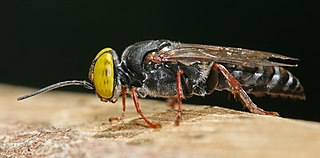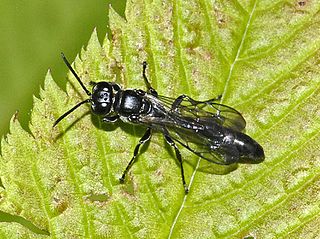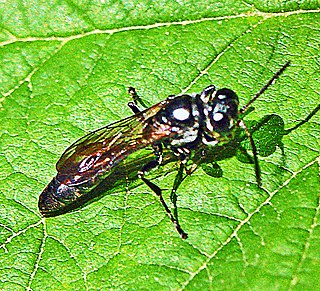
Convolvulaceae, known commonly as the bindweed or morning glory family, is a family of about 60 genera and more than 1,650 species of mostly herbaceous vines, but also trees, shrubs and herbs, and also including the sweet potato and a few other food tubers.

Lycopodium is a genus of clubmosses, also known as ground pines or creeping cedars, in the family Lycopodiaceae. Two very different circumscriptions of the genus are in use. In the Pteridophyte Phylogeny Group classification of 2016, Lycopodium is one of nine genera in the subfamily Lycopodioideae, and has from 9 to 15 species. In other classifications, the genus is equivalent to the whole of the subfamily, since it includes all the other genera. There are then more than 40 accepted species.

The Crabronidae are a large paraphyletic group of wasps, including nearly all of the species formerly comprising the now-defunct superfamily Sphecoidea. It collectively includes well over 200 genera, containing well over 9000 species. Crabronids were originally a part of Sphecidae, but the latter name is now restricted to a separate family based on what was once the subfamily Sphecinae. Several of the subfamilies of Crabronidae are often treated as families in their own right, as is true of the most recent phylogenies.

Lycopodium clavatum is the most widespread species in the genus Lycopodium in the clubmoss family.

The organ pipe mud dauber is a predatory wasp in the family Crabronidae. They are fairly large wasps, ranging from 3.9–5.1 cm, and have been recorded to fly from May to September. Female and male are similar in colour, a shiny black with pale yellow to white hind hindtarsomere. The organ pipe mud dauber feeds mainly on three genera of spider: Neoscona, Araneus, and Eustala. Melittobia, a parasitoid wasp, is a common ectoparasite of T. politum prepupae. Other sources of parasitism include the Bombyliid fly Anthrax, Chrysidid wasps, and various species of scavenger flies (Miltogramminae). The tufted titmouse is a known predator of T. politum, and may feed on them more commonly than previously thought as the holes made by the titmouse are similar in shape and size to those made by T. politum leaving the nest after pupation.

The subfamily Crabroninae(digger wasps) is the most diverse group in the wasp family Crabronidae, containing over 110 genera and 4,800 described species. The subfamily consists of solitary, predatory wasps. The adult females of many groups dig tunnels in the ground for nesting, but others use different techniques, including the construction of tube-like mud nests.

Epilobium clavatum is a species of flowering plant in the evening primrose family known by the common names talus willowherb and clavatefruit willowherb. It is native to western North America from Alaska to northern California to Colorado, where it grows in rocky high mountain habitat such as talus. It is a clumping perennial herb forming bristly mounds up to about 20 centimeters high and spreading outward via tough stolons. The oval-shaped leaves are 1 to 3 centimeters long. The inflorescence is an erect raceme of flowers, each with four small pink petals. The fruit is a capsule up to 4 centimeters long.

Gymnosoma clavatum is a species of tachinid flies in the genus Gymnosoma of the family Tachinidae.
Cirsium clavatum, the Fish Lake thistle or fringed thistle, is a North American species of plants in the thistle tribe within the sunflower family. The species is native to the western United States, the States of Wyoming, Colorado, Utah, Arizona, and New Mexico.
Lycopodium lagopus is an arctic and subarctic species of plants in the genus Lycopodium in the clubmoss family. It is widespread in cold, northerly regions: Canada, Greenland, Russia, Scandinavia, and the northern United States including Alaska.

Chrysidea pumila is a species of cuckoo wasps belonging to the subfamily Chrysidinae. Some authors consider this species as a synonym of Trichrysis pumilionis Linsenmaier, 1987.

Trypoxylon is a genus of wasps in the family Crabronidae. All Trypoxylon species that have been studied so far are active hunters of spiders, which they paralyse with a venomous sting, to provide as food to their developing larvae. Depending on the species, they will either construct their own nest from mud or find cavities that already exist. These cavities can range from keyholes to nail holes to previously abandoned nests, and are generally sealed with mud to create cells for their larvae.

Trypoxylon scutatum is a predatory wasp in the family Crabronidae.
Trypoxylon frigidum is a species of square-headed wasp in the family Crabronidae. It is found in North America.

Trypoxylini is a tribe of traditional Sphecidae in the family Crabronidae. There are at least 840 described species in Trypoxylini.

Trypoxylon collinum is a species of square-headed wasp in the family Crabronidae. It is found in North America. It nests inside hollow tubes.
Trypoxylon lactitarse is a species of square-headed wasp in the family Crabronidae. It is found in Central America, North America, and South America. These are fairly common harmless black wasps that build muddy elongate nests on the external walls of houses and low-story apartments. Their characteristic nests resemble pan-flutes in shape, and are provisioned with spiders captured and paralysed by the mother wasp. It lays an egg within each elongate nest cell amongst the invalid spiders, from which a larva will hatch and slowly consume all spiders as food. This species apparently undergoes four larval moults until completing their development as pupae inside a black cocoon.

Trichrysis cyanea is a species of cuckoo wasps, insects in the family Chrysididae.

Chrysis angustula is a species of cuckoo wasps, insects in the family Chrysididae.













